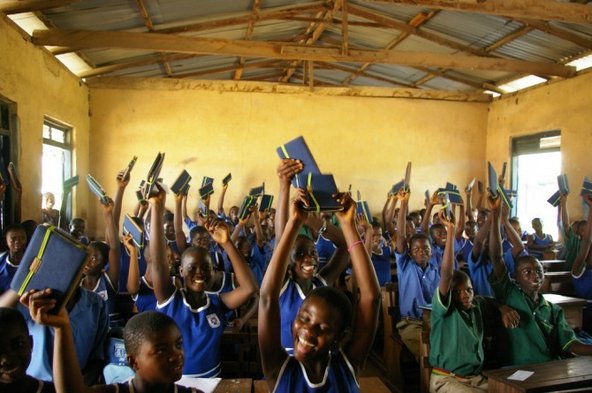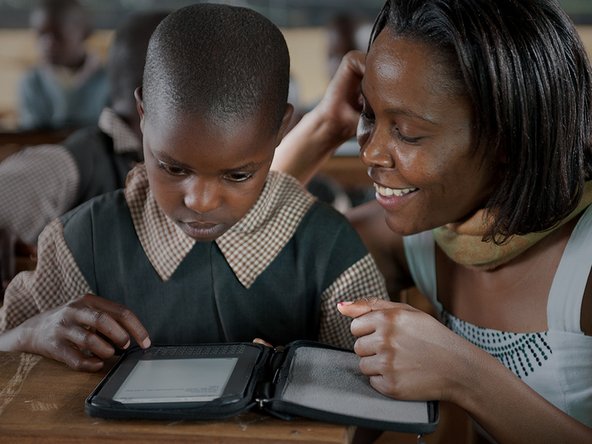This post originally ran with The Atlantic.
Photo credit: Worldreader.
Getting textbooks into classrooms can be expensive and challenging anywhere, all the more so in rural sub-Saharan Africa—where those textbooks are in direly short supply. In five African schools, a non-profit organization called Worldreader is piloting a high-tech solution: a Kindle for every student. Though the initial cost is higher than a set of textbooks, it’s much easier to add new textbooks and offer a huge variety of content.
Worldreader has already distributed a thousand Kindles, each already stocked with hundreds of e-books: everything from storybooks and “Easy English Learning for Junior High School” to Crime and Punishment. They’ve particularly worked to make books by local authors available, by establishing publishing partnerships with Ghanaian and Kenyan publishers.
But there’s some irony in the fact that the top item on the list of Worldreader books is a short story called “E is for E-Waste.” School children didn’t just get to read about e-waste, they got an unanticipated firsthand education in the delicate lifecycle of electronics. Over the course of the pilot study in Ghana, 40.5% of the Kindles broke. In their report, Worldreader called this breakage rate “unexpectedly high”; Andrew Webster of The Verge called it “a surprisingly large amount.”
The Kindle screen is just 2 millimeters thick and is glued into a plastic shell. When iBooks Textbooks debuted in January, our primary concern was broken iPads—kids are not known to treat their belongings delicately. Why didn’t Worldreader have a contingency plan for broken Kindles? The elementary, middle, and high schoolers in the study, 43% of whom had never used a computer before, were all from rural Ghana, primarily living and working on farms. Those who took the Kindles home shared them with younger siblings, read while working, and stuffed the devices into pockets and bags. Searching Amazon’s site alone returns 82,500 results for “broken kindle screen,” including reports from people whose screens broke before they’d even touched the device.
A broken Kindle is disappointing, yes. Expensive, yes. But unexpected? How could it be?
Photo credit: OLPC.
Perhaps the best implementation of educational technology in the developing world, One Laptop Per Child (OLPC) designed their own laptop—it’s durable, light, can withstand extreme conditions, and, most importantly, is easily repairable by the children themselves. Remove four Phillips screws, and the screen’s off. Four more screws, and the motherboard’s off. Their repair and troubleshooting guides are available on each laptop and online, and they are also developing a list of sources for repair parts.
That’s how it’s done right. Giving kids a bunch of Kindles is not. Kindle repair parts aren’t widely available. Amazon representatives have even evidently told customers that they have no Kindle repair facilities. When I broke my Kindle’s screen a couple of months ago, the representative I spoke to would neither confirm nor deny this claim—but she spoke repeatedly of perhaps being able to “replace” my broken Kindle, never even using the word “repair.” I attempted to repair it myself by salvaging parts from another Kindle, but discovered to my dismay that the e-ink screen is practically welded to the plastic frame with a powerful adhesive. Getting the new screen out of its frame presents a high breakage risk. Yes, it is possible to fix a Kindle. But it’s prohibitively difficult for most people, especially teachers in Ghana without access to replacement parts.
Photo credit: Worldreader.
So, what could Worldreader learn from OLPC? First, pick durable hardware. Kids need stuff that will hold up to rough conditions, all the more so when they’re living and working on farms. Worldreader and Amazon are developing more rugged Kindles “with more durable screens.” And they’re encouraging kids to be more careful by requiring parent-teacher conferences and a verbal warning for anyone who breaks a Kindle.
But that may not be enough. The devices should be repairable, too. There’s no reason why a kid should have to wait three months to have a screen replaced. Five-year-olds fix their own OLPCs. Every day, we hear from kids who have used our repair guides to fix their own electronics. I just got back from the USA Science and Engineering Festival, where I watched hundreds of middle schoolers fixing iPods and DVD players. With good guides and the right tools, kids don’t have any more trouble repairing electronics than they do putting together a Lego set.
Why not ship the Worldreader devices with repair manuals? Why not give schools a supply of repair parts? Why not teach all children in the program how to fix their own e-readers? Fewer devices would break. Kids wouldn’t go three months without access to their textbooks. They would learn valuable engineering skills.
Worldreader, if you’re reading, we’d love to help: if you develop a more repairable device, we’d be happy to write your repair manuals for free. Know anyone else starting an educational technology non-profit? Our offer is open to them, too. But please, factor repairability into the beginning of the planning process. Hardware can and will break—that’s expected and normal. Building a plan for maintaining the hardware should be normal as well.








댓글 한 개
Kindle is delicate like any other phone or electronic device. Careful handling is required and this device is not primarily developed for kids in first place. Fixing broken kindle is difficult and as mentioned screen is practically welded to the plastic frame with a powerful adhesive and most of the time things worsen with Kindle repair. There are few kindle not working issues which can be fixed easily.
Edgar n Brown - 답글